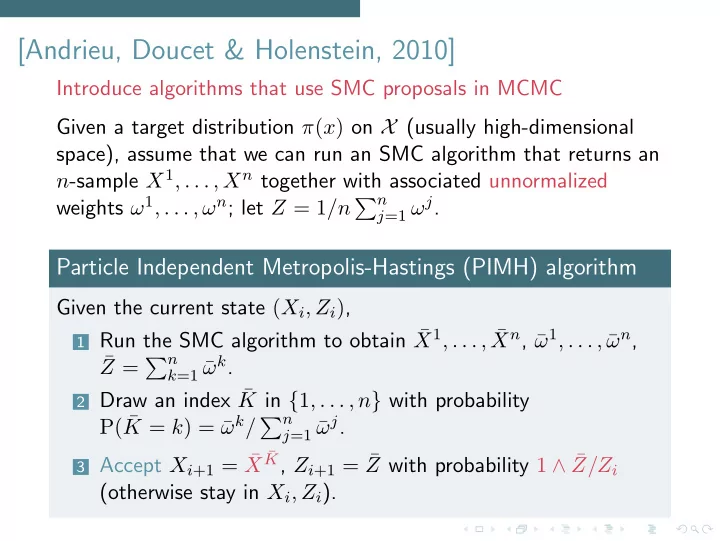

[Andrieu, Doucet & Holenstein, 2010] Introduce algorithms that use SMC proposals in MCMC Given a target distribution π ( x ) on X (usually high-dimensional space), assume that we can run an SMC algorithm that returns an n -sample X 1 , . . . , X n together with associated unnormalized weights ω 1 , . . . , ω n ; let Z = 1 /n � n j =1 ω j . Particle Independent Metropolis-Hastings (PIMH) algorithm Given the current state ( X i , Z i ) , 1 Run the SMC algorithm to obtain ¯ X 1 , . . . , ¯ X n , ¯ ω 1 , . . . , ¯ ω n , Z = � n ¯ ω k . k =1 ¯ 2 Draw an index ¯ K in { 1 , . . . , n } with probability P( ¯ ω k / � n ω j . K = k ) = ¯ j =1 ¯ X ¯ 3 Accept X i +1 = ¯ K , Z i +1 = ¯ Z with probability 1 ∧ ¯ Z/Z i (otherwise stay in X i , Z i ).
ω j ) j =1 ,...,n is produced by direct Proof [Assuming that ( ¯ X j , ¯ importance sampling with instrumental pdf q (i.e. no resampling)] 1 The important idea is that the state of the chain is in fact ( X 1 , . . . , X n , K ) and that the targeted auxiliary distribution has pdf π aux ( x 1 , . . . , x n , k ) = 1 nπ ( x k ) � q ( x j ) j � = k 2 Check that indeed X K has marginal distribution π under π aux 3 The proposal distribution is independent of the current state and is given by x ¯ x ¯ k ) /q (¯ k ) π (¯ x n , ¯ q aux (¯ x 1 , . . . , ¯ � x j ) k ) = q (¯ x l ) /q (¯ x l ) � l π (¯ j
4 The Metropolis-Hastings acceptance ratio is given by x n , ¯ π aux (¯ x 1 , . . . , ¯ q aux ( x 1 , . . . , x n , k ) k ) k ) = ¯ z x N , ¯ π aux ( x 1 , . . . , x N , k ) q aux (¯ x 1 , . . . , ¯ z as x ¯ x n , ¯ 1 k ) � x j ) π aux (¯ x 1 , . . . , ¯ n π (¯ k q (¯ k ) j � =¯ k ) = x n , ¯ x ¯ x ¯ q aux (¯ x 1 , . . . , ¯ π (¯ k ) /q (¯ k ) x j ) � j q (¯ x l ) /q (¯ x l ) P l π (¯ = 1 � x l ) /q (¯ x l ) = ¯ π (¯ z n l 5 Keeping the whole state ( X 1 , . . . , X n , K ) is not required and one only needs to keep track of X K and Z
The method can defeat the curse of dimensionality (at a certain price...) ACCEPTANCE RATE 4 10 1 0.9 0.8 0.7 Number N of Particles 3 10 0.6 0.5 0.4 2 10 0.3 0.2 0.1 1 10 0 0 1 2 3 10 10 10 10 Dimension T Figure: PIMH acceptance rate as a function of the dimension T of the target and the number N of particles. The target pdf is π T ( x 1 , . . . , x T ) = Q T t =1 π ( x t ) , where π is the normal pdf truncated to the range [ − 4 , 4] ; the SMC proposal “kernel” q is an independent proposal, uniformly distributed in the range [ − 4 , 4] . To assess the difficulty of the simulation task, note that for direct self-normalized importance sampling targeting π T the R 4 Effective Sample Size (ESS) statistic, normalized by N , tends to 2 . 26 − T ( 2 . 26 = − 4 8 π 2 ( x ) dx ) as N increases, which is about 10 − 6 for T = 17 .
Recommend
More recommend